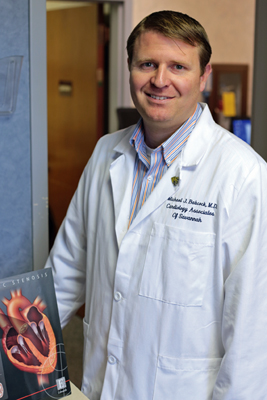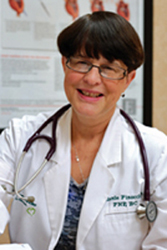Knowledge for Life: Heart Disease
One in every four deaths in the United States is caused by heart disease, according to the Centers for Disease Control and Prevention. That equals about 600,000 people. Such a high number reflects how the wonderful complexity of the heart also makes it susceptible to several kinds of disease.
“The heart is the most important four-room house that you’ll ever own,” says cardiologist Michael J. Babcock, MD. “It has walls—which are the pumping chambers of the heart. It has doors between the rooms, which are the cardiac valves. It has a plumbing system, the coronary arteries, and an electrical system that controls the heart rhythm. All of these parts can be affected by disease, and the symptoms can overlap and interact with each other. These symptoms can be very profound, but can often be more subtle.”

February is American Heart Month, a crucial time for the physicians, nurses, and staff in The Heart Hospital at St. Joseph’s/Candler to raise awareness. They hope that education of risk factors and screenings will help prevent people of this region from becoming part of the daunting statistics of heart disease.
The most common type of heart disease is coronary heart disease, which is sometimes referred to as coronary artery disease. Both terms refer to the buildup of plaque on the artery walls, which eventually restricts the flow of oxygen
to the heart.
Risk Factors
With coronary heart disease, some risk factors can’t be changed:
Gender. According
to the American Heart Association (AHA), the risk of heart disease is greater for men even compared to women who have gone through menopause and face increased risk because of it. Women remain at risk as well, but often present with more subtle symptoms.
Any symptoms should warrant increased screening.
Family history. “Because genetics plays a role in heart disease risk, we want to identify those with a family history of heart disease sooner so that we can aggressively
treat other modifiable risk factors,” Dr. Babcock says.
Age. People 65 or older are a higher risk, as the buildup of plaque can take time, even decades.
Some risk factors can be changed, either
through lifestyle changes, medication, or both:
High blood cholesterol. Heredity can be a factor in high blood cholesterol, which increases the risk for coronary heart disease, but medication can help. This is
something Melanie Finocchiaro FNP, BC, a nurse practitioner in The Heart Hospital, knows firsthand.

“I eat right and exercise but still have high cholesterol,” Finocchiaro says. “So I make sure to take my medicine.”
High blood pressure.This condition causes heart muscle and blood vessels to grow
stiffer and can affect their ability to work properly. Just as with cholesterol, medication may be needed for high blood pressure in addition to proper diet and exercise
Smoking. Dr. Babcock considers smoking
to be both the most notorious risk factor and the most modifiable. “Any amount of smoking can act as almost a literal glue to the coronary blood vessels,” he says.
Diabetes. At least 65 percent
of people with diabetes die of some form of heart or blood vessel disease, according to the AHA.
As with high blood pressure and high cholesterol, exercise and diet can lower your risk of diabetes. In turn, being overweight or obese
can increase the risk of all of these conditions.
“People have to think prevention,” Finocchiaro says. “If you really work at staying slender and eating right, you can prevent diabetes and help control other risk
factors.”
“We like to call it the triad—exercise, diet, and medication,” she adds.
Screenings
A look at the risk factors for heart disease provides the clues for the recommended screening tests for heart disease prevention. These screenings can usually be completed through your family practitioner or primary care physician:
Fasting lipid profile. This blood test measures total, as well as good and bad, cholesterol levels.
Blood pressure. Measured at every doctors visit but can be tracked at home as well.
Body weight. Often measured at home and should be monitored for changes.
Blood glucose. High glucose levels will indicate that you are at a higher risk for diabetes.
The blood glucose
screening generally begins at age 45, though your doctor may recommend one earlier based on your weight and other risk factors. The other screenings begin around age 20. Your doctor will also want to assess your physical activity and diet, and will
of course need to know whether or not you smoke.
“If symptoms develop, the threshold for screening changes,” says Dr. Babcock. Symptoms such as dizziness or irregular heartbeat can be investigated by electrocardiogram,
or EKG. Symptoms of worsening fatigue, shortness of breath or chest discomfort may warrant cardiac ultrasound or stress testing.
The EKG can also check the health of the heart when one or more of the risk factors are present.
“An abnormal EKG could be a way to uncover significant cardiac disease before it becomes symptomatic,” Dr. Babcock says.
The earlier that a person can recognize risk factors that can't be changed and modify the ones
that can, the better.
“Symptoms can sometimes be so gradual that unless you and your doctor are asking the right questions, they can be missed,” Dr. Babcock says. “That’s why awareness of these risk factors
is so important.”
Coronary heart disease can sometimes lead to a heart attack. Learn more about the signs and symptoms of a heart attack, and how they can differ between men and women, in our Ask A Magnet Nurse feature.